中山岐江公园/土人(经典案例)
- 格式:docx
- 大小:4.08 MB
- 文档页数:35
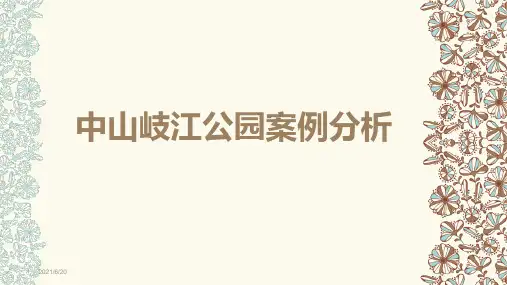
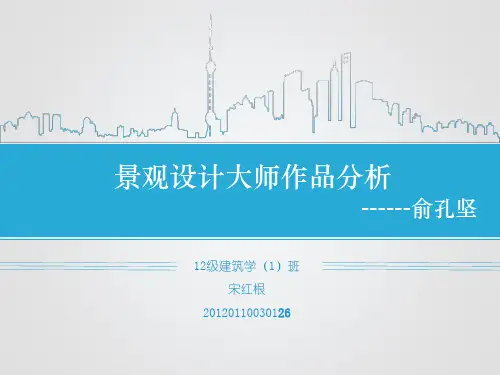
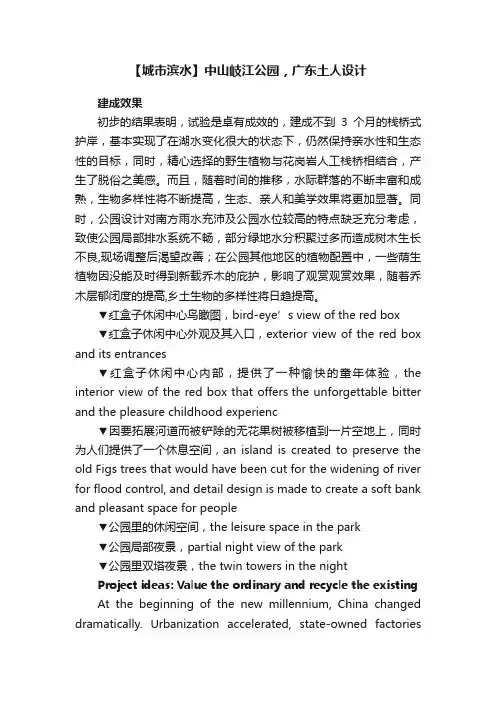
【城市滨水】中山岐江公园,广东土人设计建成效果初步的结果表明,试验是卓有成效的,建成不到3个月的栈桥式护岸,基本实现了在湖水变化很大的状态下,仍然保持亲水性和生态性的目标,同时,精心选择的野生植物与花岗岩人工栈桥相结合,产生了脱俗之美感。
而且,随着时间的推移,水际群落的不断丰富和成熟,生物多样性将不断提高,生态、亲人和美学效果将更加显著。
同时,公园设计对南方雨水充沛及公园水位较高的特点缺乏充分考虑,致使公园局部排水系统不畅,部分绿地水分积聚过多而造成树木生长不良,现场调整后渴望改善;在公园其他地区的植物配置中,一些荫生植物因没能及时得到新载乔木的庇护,影响了观赏观赏效果,随着乔木层郁闭度的提高,乡土生物的多样性将日趋提高。
▼红盒子休闲中心鸟瞰图,bird-eye’s view of the red box▼红盒子休闲中心外观及其入口,exterior view of the red box and its entrances▼红盒子休闲中心内部,提供了一种愉快的童年体验,the interior view of the red box that offers the unforgettable bitter and the pleasure childhood experienc▼因要拓展河道而被铲除的无花果树被移植到一片空地上,同时为人们提供了一个休息空间,an island is created to preserve the old Figs trees that would have been cut for the widening of river for flood control, and detail design is made to create a soft bank and pleasant space for people▼公园里的休闲空间,the leisure space in the park▼公园局部夜景,partial night view of the park▼公园里双塔夜景,the twin towers in the nightProject ideas: Value the ordinary and recycle the existing At the beginning of the new millennium, China changed dramatically. Urbanization accelerated, state-owned factorieswent bankrupt, and millions of workers lost their jobs. Together with other old buildings and the vernacular landscape, old factories that occupied central urban space were being demolished for new development, less because their land had high value than because they were considered outmoded and ugly. At the same time, city governments were becoming rich largely because of the preceding years’ open economic policy. China’s “City Beautiful Movement” heated up, mixing European Baroque and traditional Chinese imperial aesthetics. Vernacular landscapes were replaced with landscapes of ornamental horticulture and rockery copied from Chinese classical gardens, along with deliberately odd-shaped buildings and structures. The Cultural Revolution was a sensitive, undiscussed topic. Parks were still gated gardens with entrance fees maintained as places for holidays and special events.When Kongjian Yu returned to China in 1997, he criticized as wasteful the country’s City Beautiful urban design and ornamental gardening and called for the preservation of vernacular heritage landscapes, including the industrial. Shipyard Park offered the first chance for him to express his values and aesthetics.Shipyard Park demonstrates Yu’s integra tion of ecological, social, economic, and cultural considerations: (1) value the ordinary and even the outmoded and consider the socialist industrial heritage of the 1950s, 1960s, and 1970s to be as precious as that of ancient traditional culture; (2) make the park integral to the urban landscape and open to the public free of customary fees for local citizens and tourists; (3) establish a new aesthetic favoring untrimmed and “weedy” native, low-maintenance plants; and (4) design the park to aid in floodcontrol, adapting it to water-level fluctuations.Project description:This park was built on the site of an abandoned, polluted, and dilapidated shipyard (erected in the 1950s and bankrupt by 1999) dotted with old docks, cranes, rails, water towers, and machinery. The design shows how landscape architects can turn a derelict site into an attractive, meaningful, and functional place, and thus contribute to urban renewal.Since the park’s lake connects through the Qijiang River to the sea, water levels fluctuate up to 1.1 meters daily. A network of bridges was constructed at various elevations and integrated with terraced planting beds so that native “weeds” from the alluvial wetland could be grown and visitors could feel a hint of the ocean.Regulations of the Water Management Bureau required that the river corridor at the east side of the site be expanded to eighty meters from sixty to manage water flow. This meant that more than ten old banyan trees were to be cut down. Turenscape instead dug a parallel ditch twenty meters wide on the other side of the trees, leaving them intact. Since remnant rusty docks and machinery are largely nuisances for local residents, three approaches were taken to artistically and ecologically dramatize the spirit of the site using preservation, modification, and creation of new forms. Native habitats, water, and cultural elements were preserved as found; existing structures, materials, and forms were reused for new functions. Vegetation along the old lake shore was preserved and modified, as were the rails, water towers, and dilapidated machines. New forms included a network of straight paths and green boxes (using figs trees as living walls), and a large red box that dramatizes the character of the site. Functionalism is evident in the network of paths linkingkey locations and exits, in the reuse of dock structures to provide tea and park services, in the light tower made from a former water tower, and in the paved areas under trees where tai chi can be practiced.项目地点:广东省中山市项目类别:海绵城市项目规模:110 000㎡设计时间:2000-7-26建成时间:2001-7-26委托方:广东省中山市规划局所获奖项:2002美国景观设计师协会设计荣誉奖,2009ULI亚太区杰出奖Location: Zhongshan, Guangdong Province, ChinaArea: 11 hectares (27 acres)Design time: designed June 1999 to May 2001; completed May 2001Awards:2009 Global Award for Excellence, Urban Land Institute2009 Asian Pacific Award for Excellence, Urban Land Institute 2008 Excellence on the Waterfront Award, The Waterfront Center, Washington, D.C.2004 Chinese National Gold Medal of Fine Arts2002 Honor Award, American Society of Landscape Architects。
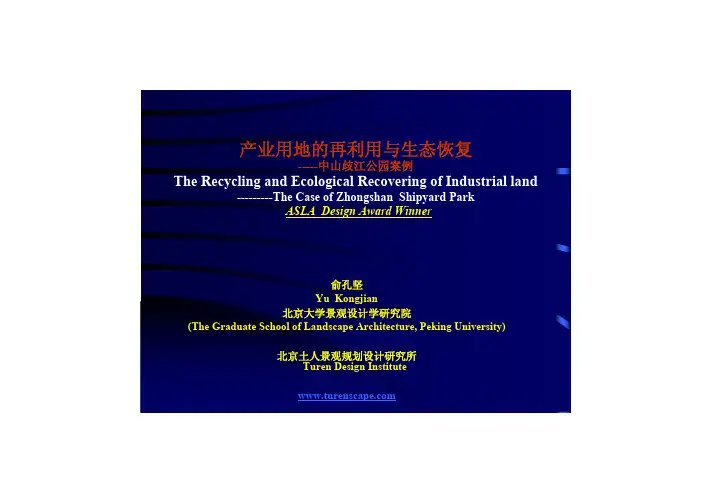
产业用地的再利用与生态恢复-----中山歧江公园案例The Recycling and Ecological Recovering of Industrial landASLA Design Award Winner俞孔坚Yu Kongjian北京大学景观设计学研究院(The Graduate School of Landscape Architecture, Peking University)北京土人景观规划设计研究所Turen Design InstituteThe Turen Concept: Nature, man and spirit as oneEarth (Tu), the perceived center of the universe, and the base of all living creatures, vertical Sacred Trees, the axis for the Sun to rise and fall and the ladders for the spirits to普遍的问题The Common Issues:生锈的弃儿The rusted and deserted• 1.什么是自然、生态和美What is nature and its beauty? Tigers? Giant panda? the flowering magnolia and roses are beautiful, so is native weeds. What is ecological?Ecological or natural does not the history of 30-40 years, and the socialist industrial culture of the 1950s and 1960s or 1970s by the common people, may be as precious as that of the thousands years’history and the Chinese traditional culture. The rusted thus been abandoned, the common thus been ignored, are to be valued.preserving, modifying existing old forms, as well as creating new forms. The philosophy:Values and EthicsThe culture being neglected and the beauty of weeds 足下的文化与野草之美:关于文化与自然的新伦理设计途径The Design Approaches •Preserve:•Reuse:to reuse existing structures, materials and forms for new •Recycle:to digest the existing forms, materials and genius loci to re-本案例:中山粤中造船厂The case of Zhongshan Shipyard11 hectares ,built in 1950s ,bankrupted in 1999,small but typical of socialist industry.公园区位图Location of the Park场地挑战与对策(1):变化的水位与栈桥式湖岸Site challenges andstrategies:fluctuating water level and terraced bridge lake shore低水位lower waterlevel 中水位middle water level 高水位an higher water level场地挑战及对策(2):古树保护、防洪与挖渠成岛Site challenges and strategies:old tree preservation、flood control and the making of an island场地挑战及对策(3):保留、再利用和再生设计Site challenges and strategies: preserve、reuse 、recycle and recreate保留设计:保留乡土群落发育良好湖岸Preserved lake shore with well established native community改造与再利用设计:船坞利用the reuse concepts of the docks改造和再利用:铁轨The reuse design for rails改造和再利用:龙门吊塔The concept for the reuse of existing cranes改造和再利用:机器与拆除的建材再利用方案The concept for the reuse of machinery and architectural materials from wreckages。
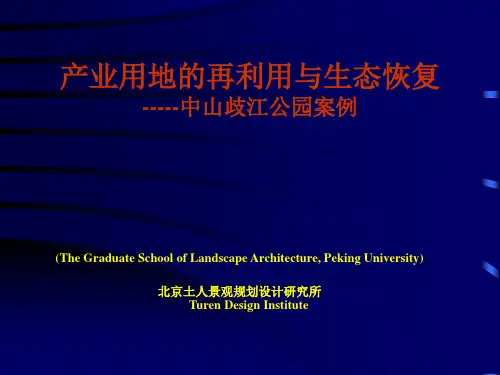
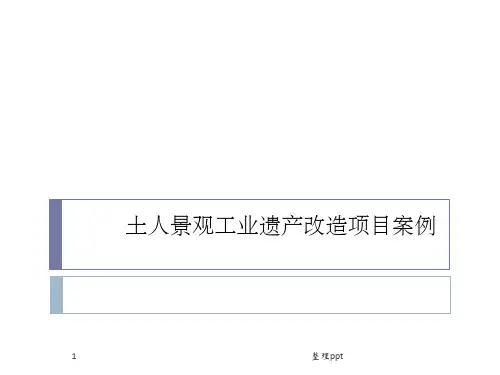
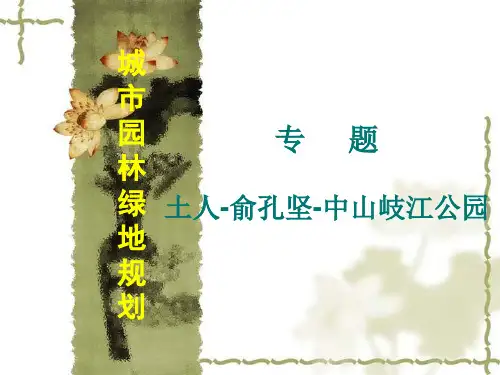
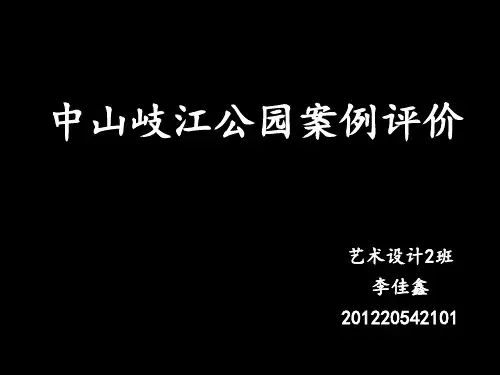
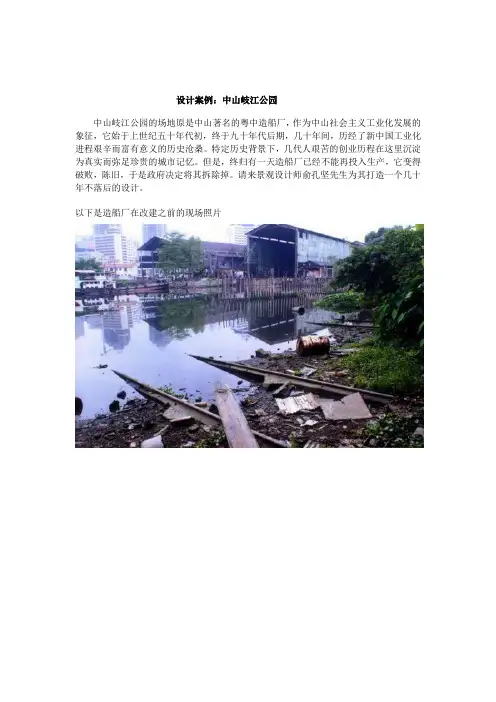
设计案例:中山岐江公园
中山岐江公园的场地原是中山著名的粤中造船厂,作为中山社会主义工业化发展的象征,它始于上世纪五十年代初,终于九十年代后期,几十年间,历经了新中国工业化进程艰辛而富有意义的历史沧桑。
特定历史背景下,几代人艰苦的创业历程在这里沉淀为真实而弥足珍贵的城市记忆。
但是,终归有一天造船厂已经不能再投入生产,它变得破败,陈旧,于是政府决定将其拆除掉。
请来景观设计师俞孔坚先生为其打造一个几十年不落后的设计。
以下是造船厂在改建之前的现场照片
接到这个项目的设计师俞孔坚先生认为这些70年代、80年代的厂房无论多么的破旧那都是中国的历史,拆掉它相当于拆掉我们的记忆。
习近平曾说望得见山,看得见水,记得住乡愁。
这里就是我们的乡愁,保留它就是要我们每一个人都能记得住乡愁。
俞孔坚先生经过对造船厂的保留再生再利用,把脏乱破败的旧厂房改造成了一个适合当代人使用的自然优美的生态公园。
一年里有5000对的情侣选择在这里拍婚纱照。
生锈的铁轨旁边种植野草,将
个人感想:
也许你和我一样有过这样的经历,曾经我们想要约上三五好友到曾经的校园走一走,看望我们的老师,坐一坐上过课的班级。
但可能回去过一次后就再也不会回去了,为什么?因为那里没有了我们的回忆,我们的教学楼被重建,我们的球场被重建,记忆中的校园也只能保存在记忆里。
我们在做设计师,除了要建设美丽的新颖的设计,同时也要为当地的居民保留住他们的回忆。
有情怀的设计才应该最好的设计。
案例来源:/ykj/design/show.php?id=71。

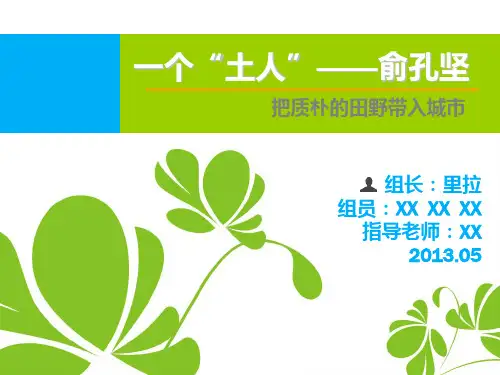
个世纪历史的旧船厂遗址,过去留——中山歧江公园下的东西很多,从自然元素上讲,场地上有水体,有许多古榕树和发文.图/简圣贤何志华育良好的地带性植物群落。
传统的设计手法多是将这些原有的植被清去中山歧江公园之前,在各类百米,场地原为粤中造船厂旧址。
从除或移栽,该公园的设计师为了保杂志上看到过多次其设计介绍,多总体规划平面图(图1)中,我们可留江边十多株古榕,同时要满足水少有些了解,但当我们第一次走进以看到该公园总体规划设计与传统利防洪对过水断面的要求,采取了这个公园的时候,还持有一些疑设计手法明显不同,多采用工业化开设支渠形成内湖的方式,对原始惑,毕竟这类工业遗址景观设计的的一些符号,比如在总体道路布局的驳岸和植物群落加以保留利用,案例在国外颇多,比如美国西雅图上采用直线形的道路系统,公园里并形成了整个公园中独特的小岛一的煤气厂公园,德国的杜伊斯堡景构筑物多以规则的几何形体呈现等。
一榕树岛(图2)。
从某种意义上来观公园等,虽未能亲身体验,但对在全园的游览中,对我们印象讲,这种保留处理的设计途径获得其设计手法却了解颇多,这次能有深刻的当属下面几个景点:(1)榕了成功,现在的榕树岛已经成为一机会前往中山歧江公园亲身体验,树岛,(2)铁轨,(3)红色记忆装个天然的水岛,在南方炎热的环境自然也多了许多期待。
置(红盒子)。
下面将结合公园中这当中显得尤其重要。
岐江公园位于广东省中山市区,几个典型的景点谈谈我们自己的感景点二:铁轨地处南亚热带。
园址东临石岐河(歧触,藉以形成对该公园设计途径的工业革命以蒸汽机和铁轨的出江),南依人民桥,北距富华酒店近感性认识和理性分析。
现为标志。
铁轨也是造船厂最具标14(krdenl#I初冬版2006.11 万方数据点,对公园的总体设计来说具有代湖的收尾之处,处理非常唐突,缺表性。
我们基本能从中感受到公园乏交代,游人走到这里突然没有了在景观设计中.主要采取了三种设计前行的道路,也没有停留的空间,应途径:保留、再利用和再生。
公园地点:位于广东省中山市,是一片城市公园绿地。
建造历史:建成于2001年10月,原场地是中山着名的粤中造船厂厂址。
该造船厂作为中山社会主义工业化发展的象征。
它始于20世纪50年代初,终于90年代后期。
设计:土人景观主要设计者:俞孔坚、庞伟、黄征征、邱钦源、李向华、凌世红奖项:2002年荣获美国景观设计师协会(ASLA)2002年度最高奖项——荣誉设计奖、2003年中国建筑艺术奖、2004年第十届全国美术作品展览环境艺术类金奖及中国现代优秀民族建筑综合金奖、2008年第22届世界城市滨水杰出设计“最高荣誉奖”;2009年国际城市土地学会(UrbanLandInstitute 简称ULI)亚太区杰出荣誉大奖。
观
中山岐江公园占地11公顷。
由于历史的原因,公园保留了刻写着真诚和壮美、却早已被岁月侵蚀得面目全非的旧厂房和机器设备,并将其重新幻化成富于生命的音符。
在公园初创阶段,面对这样一个经典而又大胆的设计,技术和质量上的要求已远不是最困难的事了,设计者和工程人员追求的是对精神与内涵的更为丰富的表现。
用两句话来概括就是:“追求时间的美,工业的美,野草的美,落差错愕的美;珍惜足下的文化,平常的文化,曾经被忽视而将逝去的文化”。
中山岐江公园2002年荣获美国景观设计师协会(ASLA)2002年度荣誉设计奖,2003年获中国建筑艺术奖,2004年分别获得第十届全国美术作品展金奖和中
国现代优秀民族建筑综合金奖。
in。